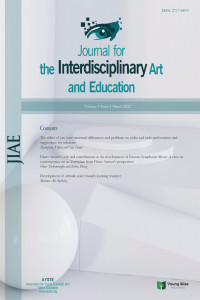From Court to Theater in the 18th Century: Birth of The Ballet d’Action (Dramatic Ballet)
From Court to Theater in the 18th Century: Birth of The Ballet d’Action (Dramatic Ballet)
Ballet which headed towards an intellectual and cultural change in the 18th Century, became a performing art reflecting all kind of emotions. The 'opera-ballet', which emerged from the ballet entrées of the early 17th Century and which was a combination of opera and ballet arts, became a genre of the French Baroque Lyric Theater in the 18th Century and continued to develop over time from the first half of this period. In the second half of the 18th Century, the ballet d’action was born as a product of choreographers who wanted to make ballet independent from opera. Jean-Georges Noverre, who wanted to tell a story through dance and mime, was the creator of the ballet d’action. According to Noverre; a ballet must be technical, at the same time be able to make the audience feel emotional depth, combine the plot of the stage and music within the story, and the pantomime must be simple and understandable. Noverre's book, "Letters on Dance and Ballet", a popular dance guide, contains his manifesto explaining how a ballet d’action should be. According to this manifesto; the theme of a ballet piece should be rational, symbolism and abstractions should be eliminated, light clothing should be preferred to bulky costumes, and the use of masks that hide facial expression should be stopped. With the reforms it went through in the 18th century, ballet became an art branch independent of opera, and together with dramatic ballet, it formed the foundations of today's ballet art.
Keywords:
Dramatic Ballet, Dance, Noverre, Sallé Camargo, Paris Opera,
___
- Anderson, J. (1974). Dance. New York, Newsweek Books
- Beaumont, C. W. (1964). Kısa Bale Tarihi. İstanbul, Elif Kitabevi.
- Bland, A. (1976). A History of Ballet and Dance in the Western World. New York, Praeger Publishers.
- Cohen, S. J. (1998). International Encyclopedia of Dance: A Project of Dance Perspectives. Oxford, Oxford University Press.
- Fairfax, E. (2003). Eighteenth-Century Ballet. Lanham, Scarecrow.
- Homans, J. (2010). Apollo's angels: A History of Ballet. New York, Random House.
- Kassing, G. (2007). History of dance: an interactive arts approach. Champaign, Human Kinetics.
- Knecht, R. J. (2014). Catherine De' Medici. New York: Routledge.
- Nye, E. (2011). Mime, Music and Drama on the Eighteenth-Century Stage: The Ballet d'Action. New York, Cambridge University Press.
- Sadie, S. (1992). The New Grove Dictionary of Opera. London, Macmillan.
- Schama, S. (1989). Citizens: A Chronicle of the French Revolution. New York, Random House.
- Web References Ballet School History. (2021, 28 January) Access Address: https://www.operadeparis.fr/en/artists/ballet-school/history
- Selvi, S. (2012, 14 October). Rokoko. Milliyet Sanat. Access Address: http://milliyetsanat.com/haberler/sanat-terimi/rokoko--mimari-/294#:~:text=Rokoko%20(Frans%C4%B1zca%20rococo)%3A%2018,Barok%20sanat%C4%B1n%20ge%C3%A7%20d%C3%B6nemi%20
- Figure References Apollo role costume in “Le Ballet de la Nuit” designed by Henri de Gissey, Louis XIV, 1658, Apollo’s Angels: A History of Ballet, Jennifer Homans, p. 666. Jean-Georges Noverre’s portrait by Jean-Baptiste Perronneau, 1764, (2020, 1 May). Access Address: https://www.operadeparis.fr/en/magazine/350-years/jean-georges-noverre-1727-1810
- Louis Michel van Loo’s portrait of Marie Sallè (1707–1756), Apollo’s Angels: A History of Ballet, Jennifer Homans, p. 667.
- Marie-Anne de Cupis de Camargo, (2020, 1 May). Access Address: https://m.blog.naver.com/PostView.nhn?blogId=hbjjeon&logNo=221578090297&proxyReferer=https:%2F%2Fwww.google.com%2F
- Paris Opera, (2020, 1 May). Access Address: (https://www.operadeparis.fr/en/news/spectator-information)
- Yayın Aralığı: Yılda 4 Sayı
- Başlangıç: 2020
- Yayıncı: Genç Bilge Yayıncılık
